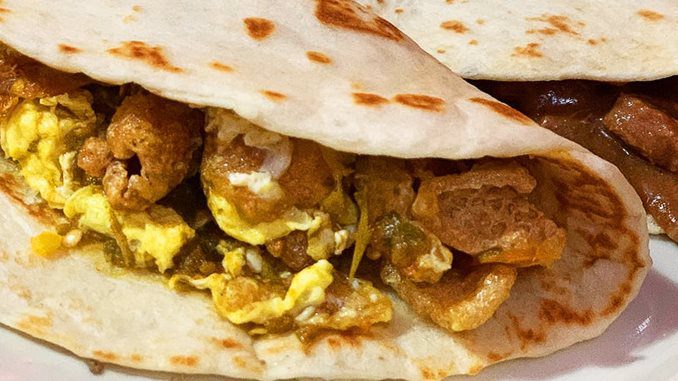If you’re a Mexican cuisine lover, undoubtedly, you know tacos and burritos.
However, many people (who aren’t fans) think of these delicacies as two similar dishes. Indeed, in a few regions, people consider burritos a taco subcategory, yet it isn’t true. The differences between tacos and burritos are rather evident.
Thus, if you want to completely understand how tacos and burritos differ from one another, today’s article is for you.
Quick Facts
Tacos:
- Wrapper: Thin and small corn tortillas.
- Origin: Way before the 18th century.
- Garnishings: Salsa, sour cream sauce, onions, cilantro.
- Serving: As a light snack.
- Size: Small.
- Fillings: Only a single variety of meat.
Burritos:
- Wrapper: Thick and large flour tortillas.
- Origin: 18th to 20th century.
- Garnishings: No specific garnishing.
- Serving: As a full meal.
- Size: Large.
- Fillings: Meat, beans, veggies, rice, etc.
Related: Top 30 Mexican dishes ranked
Main Differences
Origin
Do you know that the term “taco” is relatively new? During the 18th and 19th centuries, Mexican silver miners introduced this word into Europe.
Dated back to the time, people usually place pre-explosion gunpowder in rocks coated in “taquito.” As an inspiration, miners called this snack “taco” due to the similar act of rolling the fillings inside the tortillas.
As a result, tacos had become a staple of the laboring class, including miners, during this period.
“Taco de minero” was formerly the name of those snacks, which lends contextual evidence to suggest that “miner’s tacos” were the earliest tacos to appear. There was also the arrival of new culinary delicacies, including taquitos (small tacos).
On the other hand, in Spanish, the phrase burrito refers to “small donkey.” However, there is minimal data to justify any of these theories.
You probably heard about Juan Mendez, a Mexican who used to serve meals from a donkey wagon. According to this theory, he kept his food toasty by covering it in flour tortillas (later on, people call burrito). Specifically, throughout the Mexican Revolution, his meal soon grew famous due to its ease of usage.
That seems fascinating, but in all likelihood, it’s not accurate. Diccionario de Mexicanismos, published in 1895, defines the burrito precisely like what we witness nowadays.
Many people believe that this dish came from Guanajuato since it was so famous there. Alternatively, others assume that the burrito’s name comes from donkey ears or burros’ wrapped bundles.
Size
Most people don’t think of the burrito as a light snack as it is much bigger than a taco when it comes to size.
While most people consider the former a whole meal, they enjoy tacos as a simple snack. Indeed, if you want to serve tacos as a full meal, it’ll call for several servings instead of a single one.
Wrap
As tacos are small and thin, the soft corn tortillas are the most favorable choice for the wrap. However, when it comes to the burrito, a corn wrapper will not suffice.
As a result of the thick double stuffing, corn tortillas become fragile and prone to break.
Alternatively, burrito covers are large, thick flour-based tortillas. Sometimes, several recipes suggest flavoring these wraps with tomatoes or greens as a fusion. If the tortillas are wide enough, people can even serve them as a meal.
Fillings
Tacos and burritos feature different contents. To begin with, the volume of components that people include in these dishes varies.
While burritos are full of different ingredients, tacos are a one-ingredient dish, making them a wonderfully simple snack to enjoy whether you’re out and about or sitting at home.
The burrito offers an entire feast in itself, with multiple ingredients that are enough to load the giant wheat wrapper to the maximum. The stuffing’s components are also remarkably diverse, with barely any limitations. Indeed, a burrito got it all – rice and beans, protein and veggies, cheese, all rolled up in a large flour wrapper.
On the other hand, there is usually a protein filling in tacos, folded in a toasted corn tortilla. However, people only stuff this delicacy with a single meat type, whether jerked pork, poultry, or beef.
Garnishings
There are several toppings that people usually add to the taco, including onions, cilantro, salsas, guacamole, and other condiments. However, burritos don’t appear to have any toppings.
How Many Calories Are In One Taco Serving?
Each serving of Mexican tacos has approximately 152 calories in it. Carbs account for 56 calories, meats are about 18 calories, and fat contributes the other 78 calories. In other words, one taco fulfills around 10% of the recommended daily calorie needs of a grownup diet which is 2,000 calories per day.
How Many Calories Are In One Burrito Serving?
A 482g portion of burrito containing meat, rice, and beans provides 1017 calories. There are 52 grams of fat, 51 grams of protein, and 85 grams of carbs within a single portion. Also, the dish boasts 7.6 grams of sugar and 9.2 grams of dietary fiber, with the remaining being complex carbs.
Should Those With Diabetes, Heart-related Issues, And Obesity Consume Tacos Frequently?
If you have diabetes, heart-related diseases, or are trying to get fit, this recipe isn’t going to work for you!
They get fried in oil and, therefore, are unhealthy. Indeed, deep frying boosts oil intake and, consequently, raises your body’s fat percentage, which isn’t beneficial for diabetic or heart-related patients or those who suffer from obesity.
Tacos Vs Burritos: Which One Is The Healthier Food?
Undoubtedly, burritos are better for your health.
Compared to tacos, burrito’s micronutrient content is greater. They contain a higher volume of iron (18.7 mg) and riboflavin (0.4 mg), and folate (43 mcg) per tortilla.
At the same time, burritos are also healthier choices for macronutrients since they include less cumulative fat and more protein than a taco. However, they do contain somewhat higher saturated fat content than their rival.

